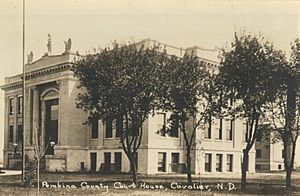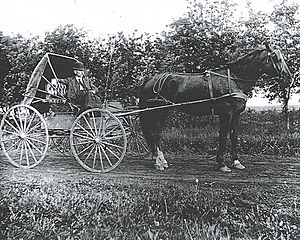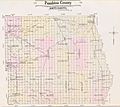Pembina County, North Dakota facts for kids
Quick facts for kids
Pembina County
|
|
|---|---|

Pembina County Courthouse before 1920
|
|

Location within the U.S. state of North Dakota
|
|
 North Dakota's location within the U.S. |
|
| Country | |
| State | |
| Founded | January 9, 1867 (created) August 12, 1867 (organized) |
| Named for | a Chippewa term |
| Seat | Cavalier |
| Largest city | Cavalier |
| Area | |
| • Total | 1,121 sq mi (2,900 km2) |
| • Land | 1,119 sq mi (2,900 km2) |
| • Water | 2.7 sq mi (7 km2) 0.2% |
| Population
(2020)
|
|
| • Total | 6,844 |
| • Estimate
(2021)
|
6,767 |
| • Density | 6.105/sq mi (2.3573/km2) |
| Time zone | UTC−6 (Central) |
| • Summer (DST) | UTC−5 (CDT) |
| Congressional district | At-large |
Pembina County is a county in the U.S. state of North Dakota. At the 2020 census its population was 6,844. The county seat is Cavalier.
Contents
History
For thousands of years, various indigenous peoples inhabited the area along the Pembina and Red rivers. At the time of European contact in the 16th century, the dominant tribes were the Assiniboine and the Lakota (or Sioux, as the French colonists called them). The Ojibwe, also known as Chippewa, a branch of the Anishinaabe-speaking language group, gradually migrated west along both sides of the Great Lakes. They developed a long trading relationship with French trappers and colonists. Throughout the Red River of the North area, French trappers married Native American women, and their descendants continued to hunt and trap. A large mixed-race population developed, recognized as an ethnic First Nations group in Canada called the Métis. The Ojibwe and Métis generally supported the French forces during the Seven Years' War in the mid-eighteenth century against Great Britain.
With the British defeat of France and takeover of its colonial territory, the Chippewa learned to deal with a new trading culture. Armed with guns by trading and having adopted the horse from the Mandan and Hidatsa, by the end of the eighteenth century the Chippewa had migrated from woodlands to the Great Plains and begun to push the Lakota west before them. By the time of the War of 1812, the Ojibwe allied with the British against the United States, hoping to forestall European-American settlers' encroaching on their territory. With the settlement of the northern boundary with Canada, the Chippewa within the Dakota Territory were forced to deal with the United States. During the first half of the nineteenth century, the Chippewa had continued conflicts with the Lakota along the Red River, finally pushing them into present-day western North and South Dakota.
Father George Belcourt, a Catholic Jesuit missionary who served them, described their territory in 1849 as the following:
"We understand here, that the district or department called Pembina, comprises all of the country or basin which is irrigated or traversed by the tributaries of the Red River, south of the line of the 49th parallel of latitude. The prairies’ rivers and lakes which extend to the height of land of the Mississippi, and the immense plains which feed innumerable herds of bison to the westward and from which the Chippewa and half breeds [Métis] of this region obtain their subsistence, contains within their limits a country about 400 miles from north to south and more than five hundred miles from east to west."
The Métis used two-wheeled, ox-drawn carts to transport great quantities of furs to market along the Red River Trails, between what is now Winnipeg, Canada and Mendota or St. Paul, Minnesota. They also used the ox-carts to transport food and shelter during extended buffalo hunts.
Over time, the Ojibwe were persuaded to cede much of their land by treaty to the US, which in turn sold it to homesteaders. They moved to relatively small Indian reservations within their earlier territory.
The precursor to Pembina County was a county of the same name in the Minnesota Territory, extending from the Upper Mississippi River to the western boundary of the territory. When Minnesota became a state in 1858, its western boundary was set at the Red River, and the land to its west was unorganized. A new Pembina County was established as part of the Dakota Territory on January 9, 1867. At the time, it was much larger than it is today. In 1871, the county was expanded to include much of the territory in what is now eastern North Dakota from Canada to the South Dakota border.
Between 1873 and 1881, eleven new counties were created from Pembina, including Cass County and Grand Forks County. Pembina took its current form in 1887, when Cavalier County was increased in size.
The first Icelandic settlements in what is now North Dakota were established in Pembina County in the late 1870s. Many of the immigrants came from New Iceland near Lake Winnipeg, along with other Icelanders who moved into the area from colonies in Wisconsin. The new settlers lived primarily in the so-called "Icelandic Townships" of Akra, Beaulieu, Gardar, and Thingwalla. The State Historical Society of North Dakota reported fewer than 3 or 4 non-Icelandic families living there in the early 1900s. Evidence of this heritage is found in several township and city names with Icelandic origins. Akra was named after the town of Akranes, near Reykjavík; Gardar was named for Gardar Svavarsson, who was reportedly the first Scandinavian to visit Iceland; and Hallsson was named for an early settler, Johann P. Hallson.
Icelandic State Park, located in Akra, was established to preserve evidence of this early pioneer heritage.
Geography
According to the U.S. Census Bureau, the county has a total area of 1,121 square miles (2,900 km2), of which 1,119 square miles (2,900 km2) is land and 2.7 square miles (7.0 km2) (0.2%) is water. The lowest point in the state of North Dakota is located on the Red River of the North in Pembina Township in Pembina County, where it flows out of North Dakota and into the Canada–US border of Manitoba.
Major highways
 Interstate 29
Interstate 29 U.S. Highway 81
U.S. Highway 81 North Dakota Highway 5
North Dakota Highway 5 North Dakota Highway 18
North Dakota Highway 18 North Dakota Highway 32
North Dakota Highway 32 North Dakota Highway 44
North Dakota Highway 44 North Dakota Highway 66
North Dakota Highway 66 North Dakota Highway 89
North Dakota Highway 89
Adjacent counties and rural municipalities
- Rural Municipality of Stanley, Canada (north)
- Rural Municipality of Rhineland, Manitoba, Canada (north)
- Town of Gretna, Manitoba (north)
- Rural Municipality of Montcalm, Manitoba, Canada (north)
- Town of Emerson, Manitoba (north)
- Kittson County, Minnesota (east)
- Walsh County (south)
- Cavalier County (west)
Demographics
| Historical population | |||
|---|---|---|---|
| Census | Pop. | %± | |
| 1870 | 1,213 | — | |
| 1880 | 4,862 | 300.8% | |
| 1890 | 14,334 | 194.8% | |
| 1900 | 17,869 | 24.7% | |
| 1910 | 14,749 | −17.5% | |
| 1920 | 15,177 | 2.9% | |
| 1930 | 14,757 | −2.8% | |
| 1940 | 15,671 | 6.2% | |
| 1950 | 13,990 | −10.7% | |
| 1960 | 12,946 | −7.5% | |
| 1970 | 10,728 | −17.1% | |
| 1980 | 10,399 | −3.1% | |
| 1990 | 9,238 | −11.2% | |
| 2000 | 8,585 | −7.1% | |
| 2010 | 7,413 | −13.7% | |
| 2020 | 6,844 | −7.7% | |
| 2021 (est.) | 6,767 | −8.7% | |
| U.S. Decennial Census 1790-1960 1900-1990 1990-2000 2010-2020 |
|||
2010 census
As of the 2010 census, there were 7,413 people, 3,257 households, and 2,069 families in the county. The population density was 6.62/sqmi (2.56/km2). There were 3,859 housing units at an average density of 3.45/sqmi (1.33/km2). The racial makeup of the county was 95.5% white, 1.9% American Indian, 0.3% black or African American, 0.1% Asian, 0.8% from other races, and 1.3% from two or more races. Those of Hispanic or Latino origin made up 2.6% of the population. In terms of ancestry, 33.8% were German, 21.3% were Norwegian, 10.6% were Irish, 9.5% were English, 8.0% were American, and 5.5% were Swedish.
Of the 3,257 households, 24.5% had children under the age of 18 living with them, 54.2% were married couples living together, 5.6% had a female householder with no husband present, 36.5% were non-families, and 32.4% of all households were made up of individuals. The average household size was 2.23 and the average family size was 2.82. The median age was 46.7 years.
The median income for a household in the county was $48,502 and the median income for a family was $61,804. Males had a median income of $40,334 versus $29,662 for females. The per capita income for the county was $27,019. About 4.0% of families and 8.0% of the population were below the poverty line, including 9.5% of those under age 18 and 11.3% of those age 65 or over.
Communities
Cities
Townships
- Advance
- Akra
- Bathgate
- Beaulieu
- Carlisle
- Cavalier
- Crystal
- Drayton
- Elora
- Felson
- Gardar
- Hamilton
- Joliette
- La Moure
- Lincoln
- Lodema
- Midland
- Neche
- Park
- Pembina
- St. Joseph
- St. Thomas
- Thingvalla
- Walhalla
Unincorporated communities
American Indian reservations
Images for kids
See also
 In Spanish: Condado de Pembina (Dakota del Norte) para niños
In Spanish: Condado de Pembina (Dakota del Norte) para niños



